2011 NISSAN CUBE tires
[x] Cancel search: tiresPage 329 of 345
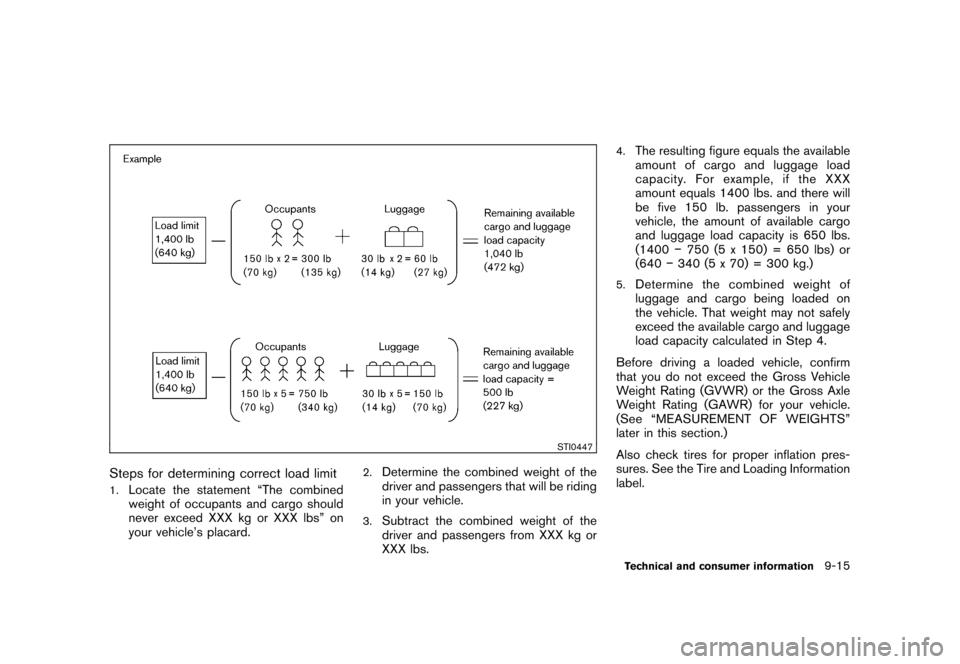
Black plate (327,1)
Model "Z12-D" EDITED: 2010/ 9/ 27
STI0447
Steps for determining correct load limit1.
Locate the statement “The combined
weight of occupants and cargo should
never exceed XXX kg or XXX lbs” on
your vehicle’s placard.
2.
Determine the combined weight of the
driver and passengers that will be riding
in your vehicle.
3.
Subtract the combined weight of the
driver and passengers from XXX kg or
XXX lbs.
4.
The resulting figure equals the available
amount of cargo and luggage load
capacity. For example, if the XXX
amount equals 1400 lbs. and there will
be five 150 lb. passengers in your
vehicle, the amount of available cargo
and luggage load capacity is 650 lbs.
(1400�750 (5 x 150) = 650 lbs) or
(640 �340 (5 x 70) = 300 kg.)
5.
Determine the combined weight of
luggage and cargo being loaded on
the vehicle. That weight may not safely
exceed the available cargo and luggage
load capacity calculated in Step 4.
Before driving a loaded vehicle, confirm
that you do not exceed the Gross Vehicle
Weight Rating (GVWR) or the Gross Axle
Weight Rating (GAWR) for your vehicle.
(See “MEASUREMENT OF WEIGHTS”
later in this section.)
Also check tires for proper inflation pres-
sures. See the Tire and Loading Information
label.Technical and consumer information
9-15
Page 332 of 345
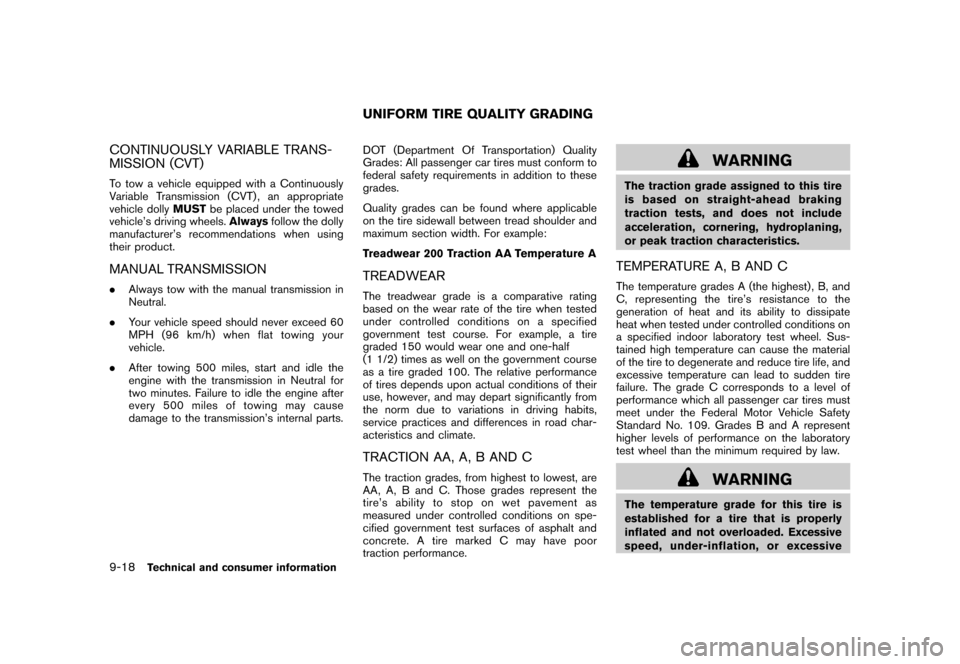
Black plate (330,1)
Model "Z12-D" EDITED: 2010/ 9/ 27
CONTINUOUSLY VARIABLE TRANS-
MISSION (CVT)To tow a vehicle equipped with a Continuously
Variable Transmission (CVT) , an appropriate
vehicle dollyMUSTbe placed under the towed
vehicle’s driving wheels. Alwaysfollow the dolly
manufacturer’s recommendations when using
their product.MANUAL TRANSMISSION. Always tow with the manual transmission in
Neutral.
. Your vehicle speed should never exceed 60
MPH (96 km/h) when flat towing your
vehicle.
. After towing 500 miles, start and idle the
engine with the transmission in Neutral for
two minutes. Failure to idle the engine after
every 500 miles of towing may cause
damage to the transmission’s internal parts. DOT (Department Of Transportation) Quality
Grades: All passenger car tires must conform to
federal safety requirements in addition to these
grades.
Quality grades can be found where applicable
on the tire sidewall between tread shoulder and
maximum section width. For example:
Treadwear 200 Traction AA Temperature A
TREADWEARThe treadwear grade is a comparative rating
based on the wear rate of the tire when tested
under controlled conditions on a specified
government test course. For example, a tire
graded 150 would wear one and one-half
(1 1/2) times as well on the government course
as a tire graded 100. The relative performance
of tires depends upon actual conditions of their
use, however, and may depart significantly from
the norm due to variations in driving habits,
service practices and differences in road char-
acteristics and climate.TRACTION AA, A, B AND CThe traction grades, from highest to lowest, are
AA, A, B and C. Those grades represent the
tire’s ability to stop on wet pavement as
measured under controlled conditions on spe-
cified government test surfaces of asphalt and
concrete. A tire marked C may have poor
traction performance.
WARNING
The traction grade assigned to this tire
is based on straight-ahead braking
traction tests, and does not include
acceleration, cornering, hydroplaning,
or peak traction characteristics.TEMPERATURE A, B AND CThe temperature grades A (the highest) , B, and
C, representing the tire’s resistance to the
generation of heat and its ability to dissipate
heat when tested under controlled conditions on
a specified indoor laboratory test wheel. Sus-
tained high temperature can cause the material
of the tire to degenerate and reduce tire life, and
excessive temperature can lead to sudden tire
failure. The grade C corresponds to a level of
performance which all passenger car tires must
meet under the Federal Motor Vehicle Safety
Standard No. 109. Grades B and A represent
higher levels of performance on the laboratory
test wheel than the minimum required by law.
WARNING
The temperature grade for this tire is
established for a tire that is properly
inflated and not overloaded. Excessive
speed, under-inflation, or excessive
UNIFORM TIRE QUALITY GRADING
9-18
Technical and consumer information
Page 341 of 345
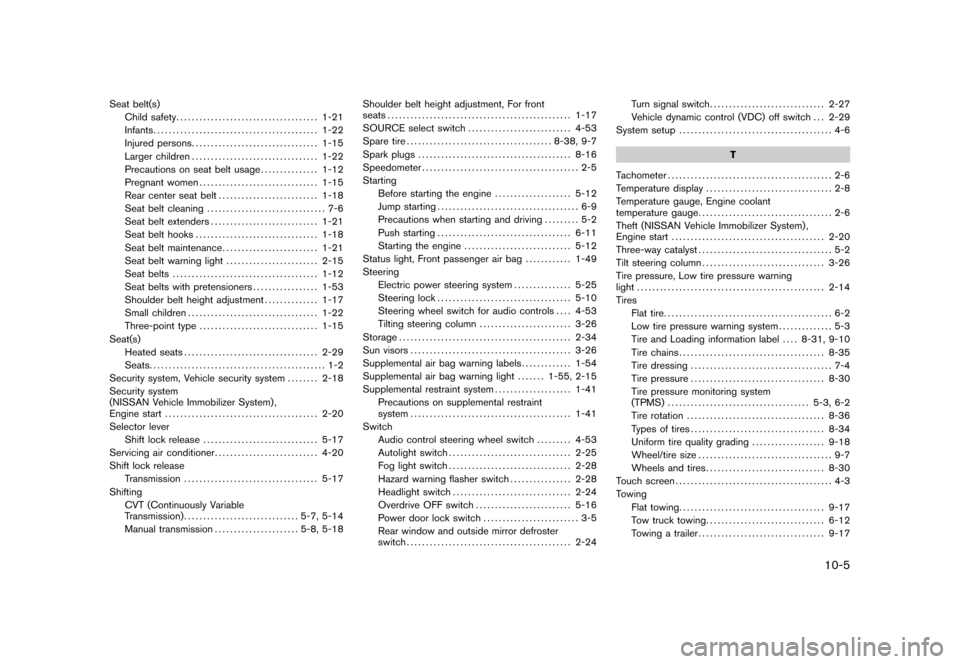
Black plate (5,1)
Seat belt(s)Child safety ..................................... 1-21
Infants ........................................... 1-22
Injured persons ................................. 1-15
Larger children ................................. 1-22
Precautions on seat belt usage ............... 1-12
Pregnant women ............................... 1-15
Rear center seat belt .......................... 1-18
Seat belt cleaning ............................... 7-6
Seat belt extenders ............................ 1-21
Seat belt hooks ................................ 1-18
Seat belt maintenance ......................... 1-21
Seat belt warning light ........................ 2-15
Seat belts ...................................... 1-12
Seat belts with pretensioners ................. 1-53
Shoulder belt height adjustment .............. 1-17
Small children .................................. 1-22
Three-point type ............................... 1-15
Seat(s) Heated seats ................................... 2-29
Seats .............................................. 1-2
Security system, Vehicle security system ........ 2-18
Security system
(NISSAN Vehicle Immobilizer System) ,
Engine start ........................................ 2-20
Selector lever Shift lock release .............................. 5-17
Servicing air conditioner ........................... 4-20
Shift lock release Transmission ................................... 5-17
Shifting CVT (Continuously Variable
Transmission) .............................. 5-7, 5-14
Manual transmission ...................... 5-8, 5-18 Shoulder belt height adjustment, For front
seats
................................................ 1-17
SOURCE select switch ........................... 4-53
Spare tire ...................................... 8-38, 9-7
Spark plugs ........................................ 8-16
Speedometer ......................................... 2-5
Starting Before starting the engine .................... 5-12
Jump starting ..................................... 6-9
Precautions when starting and driving ......... 5-2
Push starting ................................... 6-11
Starting the engine ............................ 5-12
Status light, Front passenger air bag ............ 1-49
Steering Electric power steering system ............... 5-25
Steering lock ................................... 5-10
Steering wheel switch for audio controls .... 4-53
Tilting steering column ........................ 3-26
Storage ............................................. 2-34
Sun visors .......................................... 3-26
Supplemental air bag warning labels ............. 1-54
Supplemental air bag warning light ....... 1-55, 2-15
Supplemental restraint system .................... 1-41
Precautions on supplemental restraint
system .......................................... 1-41
Switch Audio control steering wheel switch ......... 4-53
Autolight switch ................................ 2-25
Fog light switch ................................ 2-28
Hazard warning flasher switch ................ 2-28
Headlight switch ............................... 2-24
Overdrive OFF switch ......................... 5-16
Power door lock switch ......................... 3-5
Rear window and outside mirror defroster
switch ........................................... 2-24 Turn signal switch
.............................. 2-27
Vehicle dynamic control (VDC) off switch . . . 2-29
System setup ........................................ 4-6
T
Tachometer ........................................... 2-6
Temperature display ................................. 2-8
Temperature gauge, Engine coolant
temperature gauge ................................... 2-6
Theft (NISSAN Vehicle Immobilizer System) ,
Engine start ........................................ 2-20
Three-way catalyst ................................... 5-2
Tilt steering column ................................ 3-26
Tire pressure, Low tire pressure warning
light ................................................. 2-14
Tires Flat tire ............................................ 6-2
Low tire pressure warning system .............. 5-3
Tire and Loading information label .... 8-31, 9-10
Tire chains ...................................... 8-35
Tire dressing ..................................... 7-4
Tire pressure ................................... 8-30
Tire pressure monitoring system
(TPMS) ..................................... 5-3, 6-2
Tire rotation .................................... 8-36
Types of tires ................................... 8-34
Uniform tire quality grading ................... 9-18
Wheel/tire size ................................... 9-7
Wheels and tires ............................... 8-30
Touch screen ......................................... 4-3
Towing Flat towing ...................................... 9-17
Tow truck towing ............................... 6-12
Towing a trailer ................................. 9-17
10-5
Model "Z12-D" EDITED: 2010/ 9/ 27
Page 342 of 345
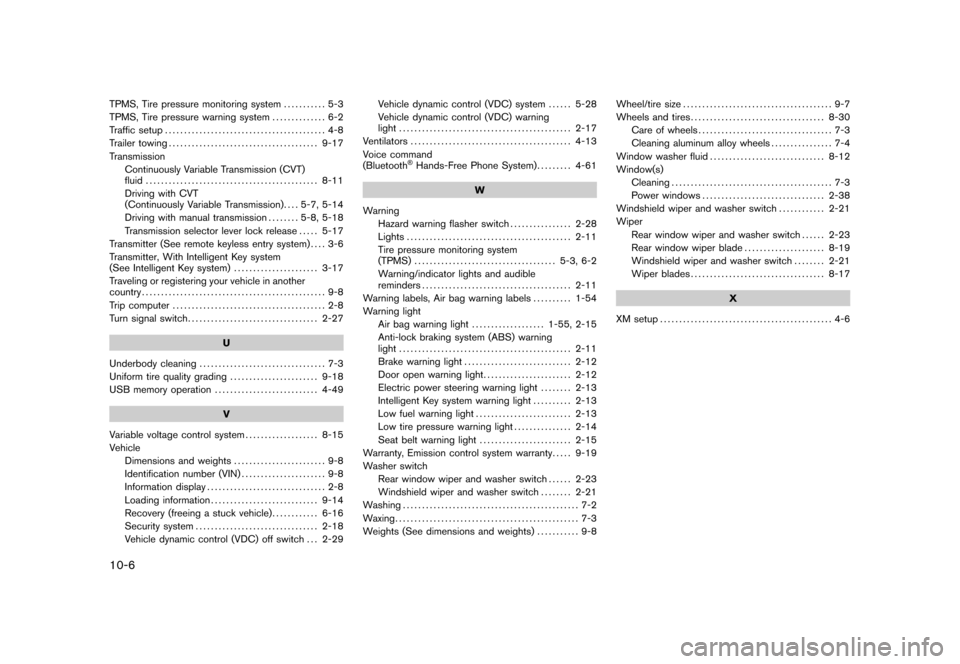
Black plate (6,1)
10-6TPMS, Tire pressure monitoring system........... 5-3
TPMS, Tire pressure warning system .............. 6-2
Traffic setup .......................................... 4-8
Trailer towing ....................................... 9-17
Transmission Continuously Variable Transmission (CVT)
fluid ............................................. 8-11
Driving with CVT
(Continuously Variable Transmission) .... 5-7, 5-14
Driving with manual transmission ........ 5-8, 5-18
Transmission selector lever lock release ..... 5-17
Transmitter (See remote keyless entry system) .... 3-6
Transmitter, With Intelligent Key system
(See Intelligent Key system) ...................... 3-17
Traveling or registering your vehicle in another
country ................................................ 9-8
Trip computer ........................................ 2-8
Turn signal switch .................................. 2-27
U
Underbody cleaning ................................. 7-3
Uniform tire quality grading ....................... 9-18
USB memory operation ........................... 4-49
V
Variable voltage control system ................... 8-15
Vehicle Dimensions and weights ........................ 9-8
Identification number (VIN) ...................... 9-8
Information display ............................... 2-8
Loading information ............................ 9-14
Recovery (freeing a stuck vehicle) ............ 6-16
Security system ................................ 2-18
Vehicle dynamic control (VDC) off switch . . . 2-29 Vehicle dynamic control (VDC) system
...... 5-28
Vehicle dynamic control (VDC) warning
light ............................................. 2-17
Ventilators .......................................... 4-13
Voice command
(Bluetooth
®Hands-Free Phone System) ......... 4-61
W
Warning Hazard warning flasher switch ................ 2-28
Lights ........................................... 2-11
Tire pressure monitoring system
(TPMS) ..................................... 5-3, 6-2
Warning/indicator lights and audible
reminders ....................................... 2-11
Warning labels, Air bag warning labels .......... 1-54
Warning light Air bag warning light ................... 1-55, 2-15
Anti-lock braking system (ABS) warning
light ............................................. 2-11
Brake warning light ............................ 2-12
Door open warning light ....................... 2-12
Electric power steering warning light ........ 2-13
Intelligent Key system warning light .......... 2-13
Low fuel warning light ......................... 2-13
Low tire pressure warning light ............... 2-14
Seat belt warning light ........................ 2-15
Warranty, Emission control system warranty ..... 9-19
Washer switch Rear window wiper and washer switch ...... 2-23
Windshield wiper and washer switch ........ 2-21
Washing .............................................. 7-2
Waxing ................................................ 7-3
Weights (See dimensions and weights) ........... 9-8Wheel/tire size
....................................... 9-7
Wheels and tires ................................... 8-30
Care of wheels ................................... 7-3
Cleaning aluminum alloy wheels ................ 7-4
Window washer fluid .............................. 8-12
Window(s) Cleaning .......................................... 7-3
Power windows ................................ 2-38
Windshield wiper and washer switch ............ 2-21
Wiper Rear window wiper and washer switch ...... 2-23
Rear window wiper blade ..................... 8-19
Windshield wiper and washer switch ........ 2-21
Wiper blades ................................... 8-17
X
XM setup ............................................. 4-6
Model "Z12-D" EDITED: 2010/ 9/ 27
Page 344 of 345
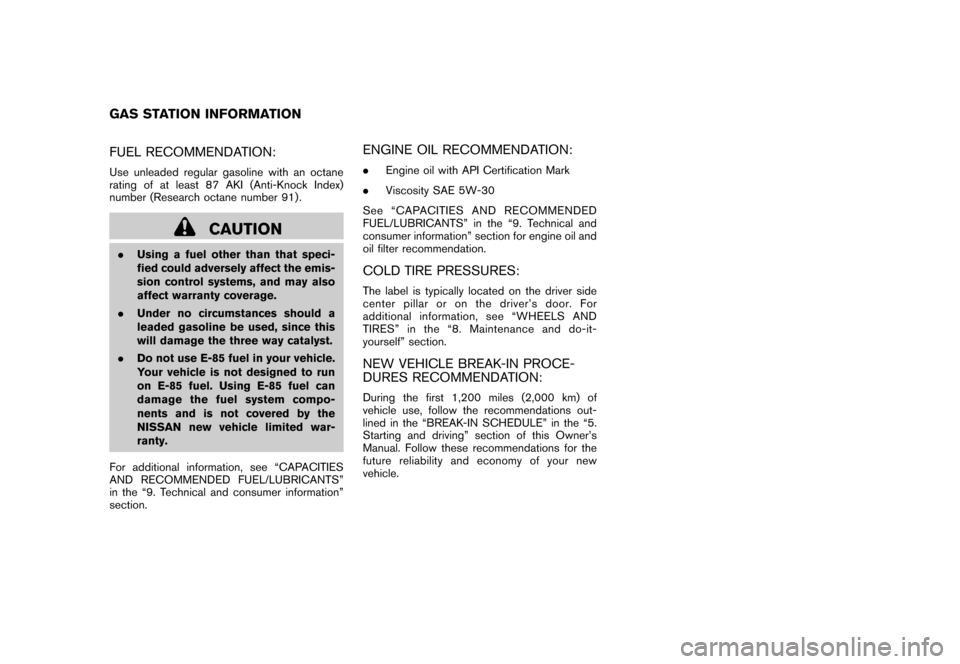
Black plate (2,1)
Model "Z12-D" EDITED: 2010/ 9/ 27
FUEL RECOMMENDATION:Use unleaded regular gasoline with an octane
rating of at least 87 AKI (Anti-Knock Index)
number (Research octane number 91) .
CAUTION
.Using a fuel other than that speci-
fied could adversely affect the emis-
sion control systems, and may also
affect warranty coverage.
. Under no circumstances should a
leaded gasoline be used, since this
will damage the three way catalyst.
. Do not use E-85 fuel in your vehicle.
Your vehicle is not designed to run
on E-85 fuel. Using E-85 fuel can
damage the fuel system compo-
nents and is not covered by the
NISSAN new vehicle limited war-
ranty.
For additional information, see “CAPACITIES
AND RECOMMENDED FUEL/LUBRICANTS”
in the “9. Technical and consumer information”
section.
ENGINE OIL RECOMMENDATION:. Engine oil with API Certification Mark
. Viscosity SAE 5W-30
See “CAPACITIES AND RECOMMENDED
FUEL/LUBRICANTS” in the “9. Technical and
consumer information” section for engine oil and
oil filter recommendation.COLD TIRE PRESSURES:The label is typically located on the driver side
center pillar or on the driver’s door. For
additional information, see “WHEELS AND
TIRES” in the “8. Maintenance and do-it-
yourself” section.NEW VEHICLE BREAK-IN PROCE-
DURES RECOMMENDATION:During the first 1,200 miles (2,000 km) of
vehicle use, follow the recommendations out-
lined in the “BREAK-IN SCHEDULE” in the “5.
Starting and driving” section of this Owner’s
Manual. Follow these recommendations for the
future reliability an d economy of your new
vehicle.
GAS STATION INFORMATION